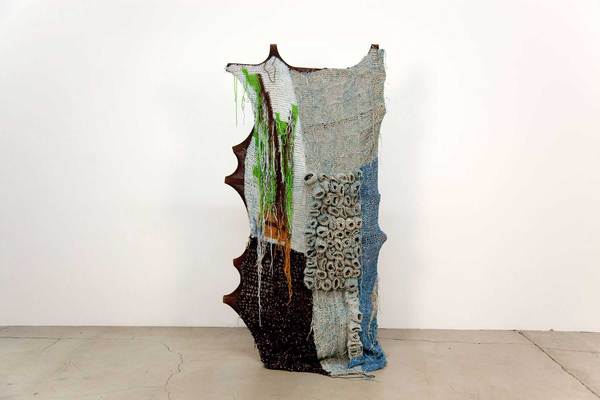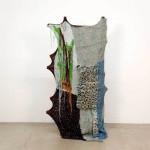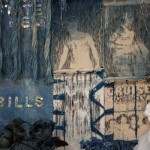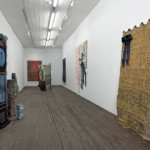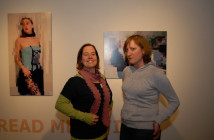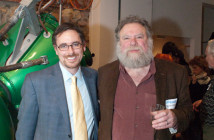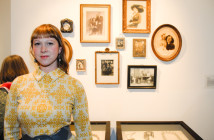Josh Faught is sculptor who works in a variety of sculptural media, focusing primarily on how textiles interact with cultural metaphors. While the Light Lasts, his current show, is on view at Lisa Cooley Fine Art, in New York. Additionally, he currently has a yearlong exhibition at the Seattle Art Museum. Alan Reid caught up with Faught earlier this month for a discussion on his current work.
*
Alan Reid: You're work is so fully concerned with craft: how did you get interested in this process; and to define, are you comfortable saying at root, the work is primarily weaving?
Josh Faught: Textiles and their histories hold a tremendous degree of my influence in my work. I use several different construction strategies: weaving, crocheting, indigo dyeing but all of them tend to co-exist within this matrix tempered by personal history and social/political history. A lot of the work that I'm currently making has a particular relationship to work that was produced in the Bay Area during the 1960s and early 1970s, when artists like Ed Rossbach were teaching these groundbreaking classes at Berkeley in Fibers and material manipulation. The artists that emerged from this time and place used textiles as a political platform, as a way of inserting a political urgency into a previously liminal history of process. I suppose my work tries to mine this history and somehow re-mythologize a new space for it: one that walks a fine line between dignity and hysteria/emotional vulnerability. My grandmother was the first person to teach to me knit.
However, I got interested in a lot of the processes from years of summer camp in Connecticut. There's something really poignant to me about the ways that summer camp functioned as this cliché site of coming of age experiences while simultaneously sparking my interests in weaving, batiking, and crocheting. But I kind of dropped it all until after I graduated from college. I was living in New York and I became obsessed with collecting these garish needlecraft manuals from the 1970s. I was looking at how the interiors in these pamphlets were punctuated by these highly expressive, oozing, knotted wall hangings, which somehow had the ability to reflect this maniacal impulse into the rest of these domestic spaces. I was also working at NEST magazine as a production intern, and became transfixed by the ways that the psychology of interiors were being re-cast through their ornamentation or decoration. It was at this point, that I decided to go back to school more explicitly to study textiles.
AR: I'd wager the craftwork of weaving is lost on much of your audience. The works in your solo show at Lisa's gallery are generated on a loom? With added crocheting? Can you describe what your studio life is like?
JF: The wallhangings I've shown at Lisa's gallery are entirely constructed by sewing together strips of loom woven fabric. I use a lot of techniques that I've bastardized from Indonesian Ikat traditions such as painting the warp (vertical) threads with nail polish or screenprinting ink before weaving in the weft (horizontal) threads. The rest of the work is all crocheted and dyed. I'm definitely not a labor fetishist, and I do wish I lot of my work could be made more quickly. At the same time, there's something really intense about the frenzied activity of touching and retouching every square inch of a piece of cloth, and somehow being able to transfer some kind of psychic/neurotic energy between your hand and the cloth, through the process.
AR: I remember you said you spent a few miserable months at the Fashion Institute, here in NYC; did you start on this path with the intentions of creating "wearable" textiles?
JF: I started studying textiles at FIT, thinking I would break into the design world. I was thinking interior fabrics more so than apparel. Within the first week however, I realized that industry and its standards were not terribly conducive to the work I wanted to produce. I finished the program at FIT, and a year later moved to Chicago for grad school.
AR: The title of your show While the Light Lasts is taken from an Agatha Christie story. I've always been drawn to the extended, formal world of Christie's novels, the stuff that's generated to support her texts -- I have a book of Tom Adams' book illustrations in my studio. And, I love the look of the BBC productions, Miss Marple and Poirot, etc. The Agatha Christie tone is so weird to me: polite, almost jolly, but hazy and replete with manslaughter. There's great comedic atmosphere. But the plots never mean much to me. I forget who was seen where, with whom, and am caught-up with the look. The isolated bicycle, the leftover Bauhaus stuff. Maybe, I'm out on a limb, but I sense a similar note in your work: I'm caught up in the isolated vignettes. Are you interested Christie's narrative structure?
JF: Totally polite, hazy, and full of manslaughter. That's the most succinct way I've ever heard someone phrase it. Perfect. I guess, in some ways the Agatha Christie novels function as this substitution for kind of a restless spirit (something to do or read to keep from idle hands being the devil's tools). Similarly, the plot structure of these books has a kind of embedded neurosis in them as well as they generally begin with a series of morally upright protagonists with quite normal and banal lives that move into disarray, darkness, and destruction by the novel's end. One of the detectives, Miss Marple, is an avid knitter as well...so I like to imagine that through her handwork she's somehow able to gain some kind of insight into the moral platitude of her characters. But I agree, the plot structures are all kind of the same, and it appears as though the visual vignettes surrounding the books (or maybe the imagined space of the reader) is somehow more interesting than any particular narrative structure.
AR: Many of the pieces in your current show have a relationship to domestic life (they contain a lot of references to the equipment of living spaces) but I don't sense a critical relationship. This I find endearing. It seems very unlike say, Linder Sterling or Mike Kelly, whose relationship to the domestic is subversive. With them, there's a sense domesticity is a site where we go to locate symptoms of institutional mismanagement, or something. Or, personal mismanagement. In your work, I sense a much more loving relationship to your objects of focus. Am I misreading? Again, you've transplanted gay-rights paraphernalia, in a caring way, to the works. To frame this in the form of a question, and not a ramble: are you interested in engineering a look at domesticity and gay paraphernalia and withholding critiquing?
JF: Oh, the work is totally complicit with the banality of domestic life. Although for many, the idea of the domestic conjures this looming sense of sterility or a threat that things could move beyond your realm of control, it's precisely the omnipresence of this threat that leaves open the possibility for a queer presence.
AR: Yes, I totally agree. Domesticity has come to serves as a code word for sterility, fear, oppression; but I really want to reject the notion. It seems a lot of ‘90s art called attention to this phenomenon. During the last fifteen years, there’s been so much Todd Solondz-type art. Now that I say it, I suppose the domestic, as a theater for threat, really is an echo of Cold War-era suburban expansion. Maybe, this anxiety was with us in the caves. Who knows? And of course, here is where new orders of living can be made -- you’re right. Art is this: despite the grumbling, it’s a utopian model. I refuse to see art making as corrupting in any way. I’m turning this towards artistry; but I’m really wondering what you mean by "queer presence" in this context?
JF: You're absolutely right. A lot of the ways that domesticity has been defined through visual culture over the past decade or so has been through an acknowledgment of fear, oppression, and dysfunction. And many of those qualities are still central to my interests in these spaces. At the same time, I think as a culture, we've developed a more complex relationship to these sites. For myself, the domestic presents an unstable veil of normalcy and anxiety through which new, more subversive activity can manifest itself. It's this instability or lack of conformity to normative behaviors that I define as queer. Or more specifically, how such panic within these sites is the precisely the condition that gives voice to new articulations of desire and difference. This is something to celebrate.
- Josh Faught, Signs of Life, hemp, wool yarn, indigo, sequins and wood, 2009.
- Josh Faught, How to Beat the High Cost of Living (detail), hand woven cotton, nail polish, toilet paper, silk flowers, indigo, sequins, and ink, 2009.
- Josh Faught, While the Light Lasts, installation view, 2010.
"While the Light Lasts" is on view until February 14th, 2010 Lisa Cooley Fine Art, located at 34 Orchard St., New York, NY.
All images are courtesy of the artist and their respective gallery.

